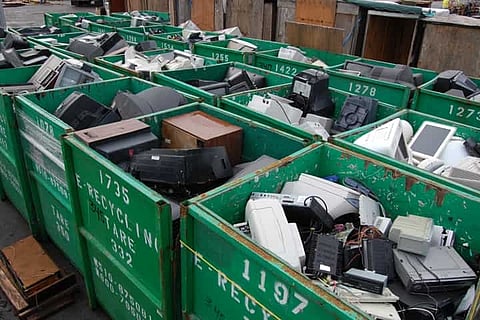

Electronic waste in 13 Latin American countries rose by 49 per cent between 2010 and 2019, roughly the world average, but just three per cent was collected and safely managed, a fraction of the 17.4 per cent global average, according to the UN's first assessment of Latin America's e-waste volume, legislation, and management infrastructure.
In 2019, e-waste generated by 206 million citizens in the 13 countries reached 1,300,000 tonnes (1.3 megatonnes, of which almost 30 per cent was plastic) -- equal in weight to a 670 km line of fully-loaded 40-ton trucks.
The comparable figure in 2010 was 900,000 tonnes, generated by about 185 million citizens.
While informal recyclers "cherry pick" some valuable elements from waste electronics and electrical equipment, some 97 per cent is improperly managed; just three per cent is known to be collected and treated in facilities using environmentally sound methods.
The findings are published in the "Regional E-waste Monitor for Latin America, Results for the 13 Countries Participating," produced by the Sustainable Cycles (SCYCLE) Programme, co-hosted by the UN University (UNU) and the UN Institute for Training and Research (UNITAR).
It was developed under the 'Strengthening of National Initiatives and Enhancement of Regional Cooperation for the Environmentally Sound Management of POPs in Waste of Electronic or Electrical Equipment (WEEE)' project, funded by the Global Environment Facility (GEF) and coordinated by the UN Industrial Development Organization (UNIDO).
"E-waste constitutes one of the fastest-growing streams of physical waste in today's global environment and is a threat to sustainable development," the report says.
However, few countries collect internationally-comparable e-waste statistics. This report was created with the cooperation of 13 countries to support and facilitate environmentally-sound management of e-waste in the region, says co-author Ruediger Kuehr, the Senior Manager of UNITAR SCYCLE (previously hosted by United Nations University).
The hazardous substances in the region's e-waste comprises at least 2,200 kg of mercury, 600 kg of cadmium, 4.4 million kg of lead, 4 million kg of brominated flame retardants, and 5.6 megatonnes of greenhouse gas-equivalents (due to refrigerants).
These substances "are poorly managed within the region and are likely to be untreated, generating various risks to the stability of a healthy environment, according to the report.
Meanwhile, "managing e-waste could be an economic opportunity," says co-author Kees Bald, Senior Scientific Specialist at UNITAR SCYCLE.
"The e-waste generated regionally in 2019 contained 7,000 kg of gold, 310 kg of rare earth metals, 591 million kg of iron, 54 million kg of copper, and 91 million kg of aluminum, representing a total value of roughly $1.7 billion of secondary raw materials."
Source : IANS